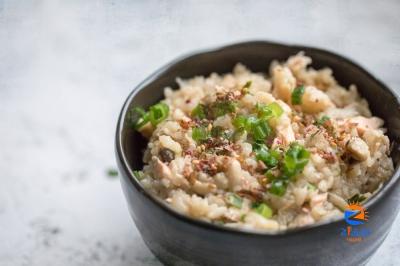
[ad_1]
KUALA LUMPUR, Sept 7 — Too many pots and pans. Too many dishes to wash.
Some weekends are meant for elaborate multi-course feasts. Some weekends, when you’re still recovering from a hectic work week, are meant for easier, less back-breaking cooking.
This is where the humble rice cooker comes in.
Beyond cooking a week’s worth of rice (usually what I use it for, with plenty of ready containers to freeze the results), the rice cooker can be a handy tool when you’re craving a delicious and nutritious meal – albeit in the form of a one-pot dish.
One convenient favourite is the Japanese classic, takikomi gohan. It is basically rice cooked in a rice cooker with some mushrooms and protein. Seasoning includes light soy sauce, mirin, cooking sake and the requisite dashi powder for a hit of umami.
You can use any type of protein you desire, from pork belly and chicken thighs to vegetarian options such as aburaage (deep-fried tofu pouches) and edamame (green immature soybeans).
Given we have taken to stocking up frozen seafood in our freezer nowadays, our go-to takikomi gohan is an easy-peasy salmon mushroom gohan that is essentially only three major ingredients: rice, salmon and mushrooms.
Try making this and you’ll soon find it to be a staple on your Weekend Kitchen repertoire!
Salmon Mushroom Gohan
Here you can use either fresh or frozen salmon. I prefer frozen salmon as it is handy to have some in the freezer. You don’t need to thaw the salmon ahead of time either; the heat and steam from the rice cooker will take care of that.
You can use either fresh or frozen salmon. — Picture by CK Lim
Mushrooms are a must for this gohan; you may use whatever type of mushrooms you prefer, from shiitake to enoki. I like pairing bunashimeji and maitake mushrooms together. The bunashimeji mushrooms have a buttery flavour while the maitake, known as “dancing mushrooms” in Japanese, have a lovely drape-like texture.
‘Bunashimeji’ mushrooms have a buttery flavour. — Picture by CK Lim
‘Maitake’ are known as ‘dancing mushrooms’ in Japanese. — Picture by CK Lim
You will need less water for cooking the rice than usual on account of the liquids from the various seasonings — the light soy sauce, mirin and cooking sake. Also the two types of mushrooms will also produce some liquid as they cook.
Some argue one should always add some oil or fat to the rice as it is cooking. I prefer to add a generous pat of butter to the rice when it is done cooking and stir everything together.
To complete the dish, use some shichimi togarashi as a finishing spice. There are different versions in the supermarket, some with ground ginger and others with nori (dried seaweed) flakes. The classic version typically contains ground red chilli pepper, ground sansho pepper and black sesame seeds.
Ingredients
1 cup uncooked short-grain rice
1 cup water
2 tablespoons light soy sauce
1 tablespoon mirin
1 tablespoon cooking sake
2 teaspoons dashi powder
50g bunashimeji mushrooms
50g maitake mushrooms
200g frozen raw salmon fillet
A pat of unsalted butter
Shichimi togarashi, for finishing
Sliced green onion, for garnishing
Method
Wash the short-grain rice, rinsing several times to remove excess starch. Put the washed and drained rice into a rice cooker pot.
Add the water, light soy sauce, mirin, cooking sake and dashi powder. Stir thoroughly until well mixed.
Mix well and scoop. — Picture by CK Lim
Layer the bunashimeji and maitake mushrooms on top, making sure to cover the entire surface of the rice and liquids. Finally place the fillet of frozen raw salmon on top.
Turn on the rice cooker and allow it to cook. Once the rice is cooked, remove the rice cooker lid and add a generous pat of unsalted butter.
Add a generous pat of butter to the cooked rice. — Picture by CK Lim
Stir the rice and the ingredients together till well combined. Ladle into bowls and garnish with some shichimi togarashi and sliced green onions. Serve immediately.
Use some ‘shichimi togarashi’ as a finishing spice. — Picture by CK Lim
[ad_2]







Your blog is a constant source of inspiration for me. Your passion for your subject matter shines through in every post, and it’s clear that you genuinely care about making a positive impact on your readers.
Comments are closed.